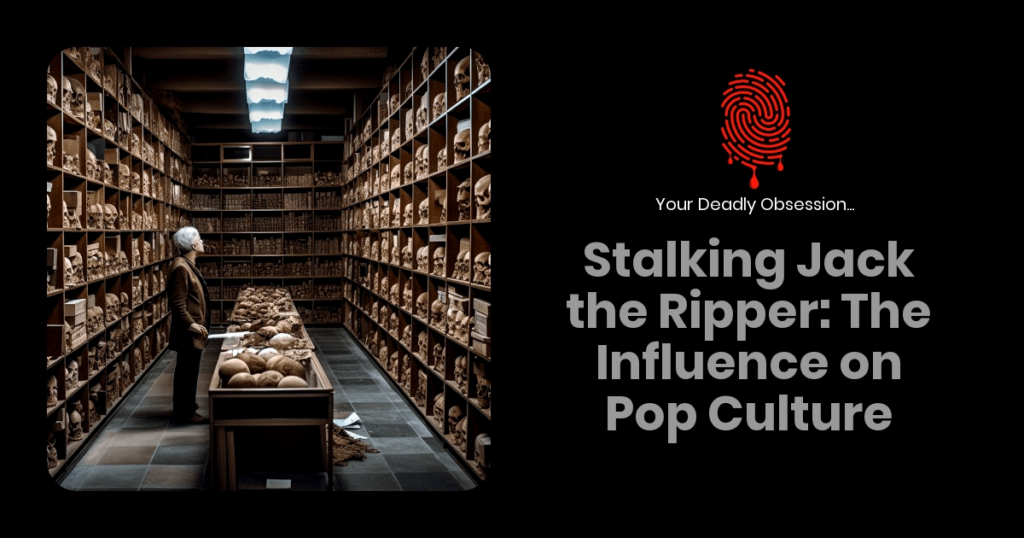Stalking Jack the Ripper delves into the dark world of unsolved crimes, specifically the notorious Jack the Ripper case. We explore the intricate details of this chilling whodunit, examining the theories surrounding the identity of one of history’s most infamous killers. With fresh insights and keen attention to detail, we shine a light on various aspects of this enduring mystery that still captivates researchers and the public alike.

Victorian London comes to life as we recount the gruesome events that unfolded in the dimly lit streets of Whitechapel back in the late 1800s. By sifting through historical records and analyzing the evidence left behind, we piece together the terrifying puzzle of the Ripper’s murderous spree. Utilizing historical context, scientific analyses, and expert opinions, we delve even deeper to help readers uncover little-known facts and connections to the case.
Our journey through the grisly world of Jack the Ripper is not only compelling but also educational, revealing intriguing information about the social, political, and scientific advancements during the Victorian era. As we take a closer look at this complex case, we ultimately aim to provide a balanced and informative overview for our readers, shedding light on a haunting series of unsolved deaths that continue to fascinate and intrigue us today.
Unraveling the Mysteries of Stalking Jack the Ripper
Diving into the chilling world of Stalking-Jack-the-Ripper, it’s hard not to get entranced by the dark, twisted tale. Weaving through the streets of Victorian London, the infamous serial killer’s gory rampage leaves a trail of unsolved murders shrouded in mystery. In this article, we’ll explore some of the enigmatic aspects surrounding the case and even attempt to uncover the Ripper’s true identity.
As we dig deeper into the case, we should familiarize ourselves with its key elements. Let’s first recap the well-known canonical five victims:
- Mary Ann Nichols
- Annie Chapman
- Elizabeth Stride
- Catherine Eddowes
- Mary Jane Kelly
These unfortunate souls were killed in a brutal manner, with a level of brutality that shocked even the hardened citizens of Victorian London. Seeking to uncover the truth, several dozen suspects have been considered throughout history, but none conclusively identified as the notorious serial killer. Here are a few noteworthy names:
- Aaron Kosminski: A Polish immigrant and barber, with a history of mental illness.
- Montague John Druitt: A barrister and schoolteacher, whose suicide coincided with the end of the killings.
- Dr. Thomas Neil Cream: A doctor and poisoner, eventually hanged for a separate string of murders.
Over the years, feverish speculation has swirled around the possible involvement of prominent figures of the time, such as theDuke of Clarence and the renowned painter Walter Sickert. Despite numerous theories, no definitive evidence has emerged to substantiate any of these claims.
Indelibly etched in the public’s imagination, the infamous Mesopotamian letter remains another key puzzle piece yet to be decoded. This chilling correspondence, written in blood-red ink, taunts the police with cryptic hints at the killer’s identity. Debates continue to this day over whether the letter was a genuine communication from the Ripper or just an elaborate hoax created by journalists to sell newspapers.
Although countless theories have been proposed over the years, they’ve fallen short of identifying the true identity of Jack the Ripper. However, with the advancements in forensic sciences and persistent efforts to unravel the mystery, there’s always the possibility that one day we might finally close the case.
In the meantime, our fascination with the grim tale of Jack the Ripper continues to captivate and haunt us, serving as a chilling reminder of the depths of human depravity and the enduring power of unexplained mysteries.
Literary Interpretations and Their Impact
Stalking Jack the Ripper has spawned various literary interpretations, each leaving a unique impact on the genre of crime and mystery. Let’s dive into some of the most notable interpretations and how they’ve shaped readers’ perceptions of the infamous serial killer.
For starters, Portrait of a Killer: Jack the Ripper—Case Closed by Patricia Cornwell stands out as a highly researched and provocative analysis. Cornwell, a well-regarded crime writer, delves into the life and identity of Jack the Ripper. By examining evidence meticulously, she presents her theory that British painter Walter Sickert is indeed Jack the Ripper, stirring up a wide range of reactions among Ripperologists.
In the realm of fiction, Alan Moore’s graphic novel, From Hell, is an artistic and atmospheric take on the Jack the Ripper story. Optimized for die-hard fans of cold cases and mysteries, Moore fuses historical facts with his dark vision, exploring the societal implications and possible motives behind the killings. This interpretation, with its rich visuals, has made a significant mark on Jack the Ripper discourse.
Another notable adaptation is The Complete History of Jack the Ripper by Philip Sugden. Renowned for its thoroughness and historical accuracy, this examination of the case takes readers on a captivating journey through time. Sugden doesn’t shy away from highlighting the controversial hypotheses surrounding Jack the Ripper, ensuring that readers remain intrigued till the end.
Below are some key literary interpretations of “Stalking Jack the Ripper”:
- Portrait of a Killer: Jack the Ripper—Case Closed by Patricia Cornwell
- From Hell by Alan Moore
- The Complete History of Jack the Ripper by Philip Sugden
- Some common themes found in these works include:
- The ongoing fascination with cold cases
- The aura of mystery that continues to surround Jack the Ripper
- The numerous theories and hypotheses that remain unresolved
In summary, the myriad literary interpretations of “Stalking Jack the Ripper” have left an indelible impact on the world of crime and mystery. The genre’s loyal fanbase, coupled with the enduring allure of unsolved cases, ensures that these interpretations will continue to generate interest, sparking discussions among both experts and enthusiasts. We are ever closer to unmasking the enigmatic killer, as the fascination with the cold case remains undeterred.
The Influence on Popular Culture
We’ve observed that Stalking Jack the Ripper has left an undeniable mark on popular culture. This fascination with one of history’s most notorious serial killers has taken countless forms, from literature and films to art and real-life investigations. In this section, we’ll delve into some notable examples that showcase the Ripper’s impact on our society.
Literature and Adaptations
- The original novel, Stalking Jack the Ripper by Kerri Maniscalco, has been a hit. It spawned an entire series of books, with three sequels exploring different historical mysteries.
- Film adaptations such as Time After Time and From Hell bring this dark character to life, offering new and thrilling perspectives on the infamous killer.
- Numerous authors have taken a crack at reimagining the story or created their own fictional works inspired by the Ripper mystery.
Art and Theatre
- The gruesome details of the case have provided a twisted source of inspiration for artists, with many creating visual interpretations of the crimes.
- In the theatrical world, Jack the Ripper: The Musical is a fascinating example of how the story has been translated to the stage.
True Crime Enthusiasts
- Even though it’s been over 130 years since the killings, dedicated true crime fans continue to investigate and analyze the available evidence, striving to unmask the identity of Jack the Ripper.
- Tours of London’s Whitechapel district are popular attractions, allowing visitors to retrace the steps of the Ripper and learn more about the victims and their stories.
| Pop-Culture Format | Examples |
|---|---|
| Books | Stalking Jack the Ripper by Kerri Maniscalco |
| Films | Time After Time, From Hell |
| Theatre | Jack the Ripper: The Musical |
| Art | Various visual interpretations |
| True Crime Investigations | Ongoing amateur investigations, Whitechapel tours |
As fans of cold cases, crime, and mystery ourselves, we can’t help but be intrigued by the lasting effect that the story of Jack the Ripper has on our culture. This grim historical figure has managed to captivate generations, and it seems that the fascination with his crimes and identity will endure for years to come. With each new adaptation or interpretation, the mystery of Jack the Ripper only grows richer and more complex, drawing in more fans and fueling our collective curiosity.
Theories Behind the Killer’s Identity
Throughout history, the identity of Jack the Ripper has remained a mystery, with numerous theories being put forth by enthusiasts and experts alike. In this section, we’ll explore some of the most popular theories surrounding this notorious killer’s identity. Keep in mind that despite the wealth of information available, definitive proof of the Ripper’s true identity has yet to be discovered.
The Royal Conspiracy Theory is a popular favorite among Jack the Ripper enthusiasts. It proposes that the murders were committed by someone with ties to the British Royal Family, and subsequently, the crimes were covered up by authorities. Proponents of this theory often point to a number of coincidences and connections to the Royal Family, such as the presence of British Freemasonry symbols at the crime scenes.
Another interesting hypothesis is the Dr. Thomas Neill Cream Theory. Dr. Cream was a Canadian doctor who specialized in abortions and was convicted of murder in 1892. It’s said that when he was about to be executed, he confessed to being Jack the Ripper. Critics, however, argue that Dr. Cream was not in London during the crimes and the confession was a last-minute attempt to save himself from execution.
Some investigators believe that Aaron Kosminski, a Polish immigrant and hairdresser, could be the killer. Kosminski was admitted to a mental asylum a few years after the last of the murders, and reportedly suffered from paranoid schizophrenia. This theory gained traction in 2014 when DNA evidence linked Kosminski to one of the crime scenes. However, many researchers have questioned the validity of the DNA results and point to insufficient evidence to definitively name Kosminski as the culprit.
Walter Sickert, a renowned English painter, is yet another intriguing suspect. Many of his artworks portrayed women in grisly situations similar to that of the Ripper’s victims. Some researchers believe that Sickert was romantically involved with one of the victims and may have been driven to kill by jealousy or betrayal. Again, critics argue that there is no solid evidence to support this theory.
Here is a table containing some key data points for these suspects:
| Suspect | Occupation | Connection to the Case |
|---|---|---|
| Royal Conspiracy | British Royalty | Freemasonry Symbols, Cover-ups |
| Dr. Thomas Cream | Canadian Doctor | Confession, similar MO |
| Aaron Kosminski | Polish Hairdresser | Mental Illness, DNA evidence |
| Walter Sickert | English Painter | Artwork, possible romantic link |
In summary, while many theories have been put forth as to the identity of Jack the Ripper, none have provided definitive proof. As such, the mystery of the Ripper’s identity continues to captivate those with an interest in cold cases, crime, and mystery. As die-hard fans, we can only hope that one day the truth will be revealed.
Controversies and Modern-Day Investigations
Despite the passage of more than a century since the Jack the Ripper murders occurred, fascination with the identity of the infamous Victorian serial killer persists. We’ve seen numerous controversies and modern-day investigations attempting to reveal the truth behind the mystery.
In recent years, there have been several theories suggesting the potential identity of Jack the Ripper. Some popular suspects include poison merchant and convicted killer Severin Klosowski, Francis Tumblety, an American quack doctor, and Walter Sickert, an artist linked to the murders by writer Patricia Cornwell. Nevertheless, no theory has been conclusively proven, and the identity of Jack the Ripper remains unresolved.
Advancements in forensic technology and DNA analysis have undoubtedly played a significant role in our modern-day quest for answers. One notable example is the analysis of a shawl retrieved from Catherine Eddowes, one of the victims. In 2014, a DNA test conducted by genetic expert, Dr. Jari Louhelainen, indicated that Aaron Kosminski, a Polish-Jewish hairdresser, may have been the killer. However, the validity of the shawl’s connection to the case and the subsequent DNA findings are still contested.
Here’s a quick overview of some of these key modern-day investigations:
- Severin Klosowski: Convicted poisoner and a major suspect in the murders.
- Francis Tumblety: An American quack doctor linked to the case due to his vast collection of female organs.
- Walter Sickert: A prominent artist whose artwork has eerie connections to the Ripper murders.
- Aaron Kosminski: A Kosminski’s DNA match to the shawl allegedly tied to the murder scene.
As the years go by, new evidence and theories continually emerge, reigniting the debate around Jack the Ripper’s identity. Some of these theories focused on women as potential suspects, dubbed “Jill the Ripper,” or speculated that the murders were part of a royal conspiracy.
In light of these controversies and modern-day investigations, it’s evident that the Jack the Ripper mystery remains one of the most enduring and intriguing cold cases in history. As die-hard fans of true crime, we can’t help but continue exploring these theories and new developments, hoping that one day the truth will finally be revealed.
Is there any romance in Stalking Jack the Ripper?
Yes, there is a romantic subplot in “Stalking Jack the Ripper.” The main character, Audrey Rose Wadsworth, develops a romantic relationship with her fellow forensic apprentice, Thomas Cresswell, throughout the novel. Their witty banter and growing chemistry add a layer of romance to the thrilling mystery.
Who is the killer in Jack the Ripper stalking?
In the novel “Stalking Jack the Ripper” by Kerri Maniscalco, the identity of the killer is revealed to be Nathaniel Wadsworth, the protagonist’s brother. Nathaniel becomes obsessed with the myth of immortality and resorts to murder in an attempt to attain it.
A Chilling Legacy: Conclusion
We’ll end our discussion of “Stalking Jack the Ripper” by diving into its chilling legacy. We’ve explored this notorious killer’s methods and motives throughout the article, and now it’s time for some final thoughts on this infamous figure. In this conclusion, we’ll provide our insights, evaluate the impact of Jack the Ripper, and describe the attraction to the mystery of his identity.
The fascination with Jack the Ripper can be attributed to several factors:
- The brutality and MO of the murders
- The lack of a confirmed identity for the murderer
- The media frenzy and sensationalism surrounding the case
These factors combined have created an enduring obsession and intrigue that continues to captivate detective enthusiasts and casual observers alike.
References:
https://en.wikipedia.org/wiki/Jack_the_Ripper

Owner & entrepreneur with a passion for murder mystery! Seriously, who doesn’t love murder mystery?
Chris is a proud member of the American Medical Writer’s Association (AMWA), the International Society for Medical Publication Professionals (ISMPP), the National Association of Science Writers (NASW), the Council of Science Editors, the Author’s Guild, and the Editorial Freelance Association (EFA).

